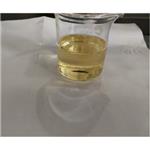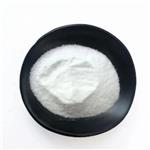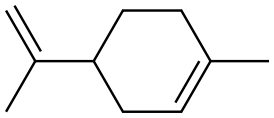Introduction of D-limonene
Jan 6,2022
General description
D-limonene is a clear colorless mobile liquid with a pleasant lemon-like odor. ((4R)-limonene is an optically active form of limonene having (4R)-configuration. It has a role as a plant metabolite. It is an enantiomer of a (4S)-limonene.)D-limonene is one of the most common terpenes in nature. It is a major constituent in several citrus oils (orange, lemon, mandarin, lime, and grapefruit). D-limonene is listed in the Code of Federal Regulations as generally recognized as safe (GRAS) for a flavoring agent and can be found in common food items such as fruit juices, soft drinks, baked goods, ice cream, and pudding.
Application and pharmacology
D-limonene or 4-isopropenyl-1-methylcyclohexene (C10H16) is a monocyclic monoterpene abundant in citrus plants like lemon, orange, and grape. The application of D-limonene in the form of flavor and fragrance additive in perfumes, soaps, foods, and beverages is consistently increased due to its high-quality fragrance property. It intended to analyze and delineate every possible available evidence and details about D-limonene with the special focus on its therapeutic efficacy. Many studies have reported that D-limonene effectively plays a valuable role in the prevention of several chronic and degenerative diseases. This review provides worthy information about the beneficial effects of D-limonene such as antioxidant, antidiabetic, anticancer, anti-inflammatory, cardioprotective, gastroprotective, hepatoprotective, immune modulatory, anti-fibrotic, anti-genotoxic etc. This could in turn help in the application of D-limonene for clinical studies. Various plant families contain Terpenes as their secondary metabolites. Monoterpenes constitute an important part of these secondary metabolites. D-limonene is a well-identified monoterpene that is commonly applied as a fragrance ingredient in essential oils. D-limonene is known to possess remarkable biological activities. It can be effectively used for treating various ailments and diseases. Due to its diverse functions, it can be efficiently utilized for human health.[1]
Numerous data on animal studies have highlighted the potential effects of D-limonene. D-limonene is well tolerated in experimental animals and protective effects of limonene were observed in several preclinical models. Animal studies showing the cardio protective and hepatoprotective effects of D-limonene are found to be inadequate. Moreover, studies exploring the anticancer efficacy of D-limonene on animal models are also found to be limited. The study on the effect of D-limonene on humans is also extremely limited. Therefore, our present review will open new avenues to undertake further research on D-limonene in preclinical models and for subjecting this compound to effective clinical trials.
Synthesis
Microbial biosynthesis of limonene also has problems such as low yield and low efficiency, which make it still challenging for the commercialization of microbial limonene production. Therefore, it is important to construct an efficient microbial cell factory for biosynthesis of limonene and further replace traditional plant extraction methods with microbial production, which will achieve important economic and social benefits. Here, the recent achievements in engineering yeast for limonene biosynthesis, and Limonene and its derivatives have great market potential with diverse applications in food, pharmaceuticals, cosmetics, etc. Commercial production of limonene and its derivatives through extraction from plants suffers from the unstable market supply, while chemical synthesis of these compounds is hindered by high energy consumption and pollutant emission. Microbial biosynthesis provides a promising alternative approach for the sustainable supply of limonene and its derivatives. However, low efficiency and specificity of the biosynthetic enzymes and pathways in heterologous hosts make it still challenging for the commercialization of microbial limonene production. [2]
Figure.1 Upstream biosynthetic pathways for supplying the isoprenoid building blocks: IPP and DMAPP. Include modified MVA pathways and artificial isoprenoid pathways.
Strain fermentation control plays an equally important role in improving the yield of limonene. How to timely adjust the fermentation strategy according to the growth and fermentation characteristics of strain high-density culture is the key. The purpose of improving the yield of limonene can be achieved by optimizing and regulating carbon source, extractant, dissolved oxygen and pH in the fermentation process, as well as multi-stage recovery of fermentation tail gas. In conclusion, it is expected to realize the directional and efficient heterologous synthesis of limonene and other terpenoids in Saccharomyces cerevisiae by combining metabolic engineering and synthetic biology, constructing high-yield limonene strains and fermentation control The complicated cellular context makes it challenging for the high production of limonene and its derivatives. Designing artificial orthogonal pathways could be feasible to avoid metabolic rigidity and properly distribute the carbon flux and redox power. Future efforts should be paid to engineer NPPS for efficient utilization of the isoprenoid precursors. A comprehensive understanding of the catalytic mechanism of limonene synthase will facilitate its engineering for higher enzyme activity and product regio-specificity, which represents an economic way to simplify the downstream processing toward the target products with higher yield and purity. In summary, we can expect that more advanced strategies will be developed for economic production of limonene by using microbes.[3]
Toxicity
D-limonene is considered to have fairly low toxicity. It has been tested for carcinogenicity in mice and rats. Although initial results showed d-limonene increased the incidence of renal tubular tumors in male rats, female rats and mice in both genders showed no evidence of any tumor. Subsequent studies have determined how these tumors occur and established that d-limonene does not pose a mutagenic, carcinogenic, or nephrotoxic risk to humans. In humans, d-limonene has demonstrated low toxicity after single and repeated dosing for up to one year. Being a solvent of cholesterol, d-limonene has been used clinically to dissolve cholesterol-containing gallstones. Because of its gastric acid neutralizing effect and its support of normal peristalsis, it has also been used for relief of heartburn and gastroesophageal reflux (GERD). D-limonene has well-established chemopreventive activity against many types of cancer. Evidence from a phase I clinical trial demonstrated a partial response in a patient with breast cancer and stable disease for more than six months in three patients with colorectal cancer.
Storge
It is volatile, afraid of light and corrosive to a certain extent, so it must be stored in a dark glass bottle with shading effect, which can reduce ultraviolet radiation by 90%. Do not use plastic bottles to store essential oils. The chemical composition of plastic will destroy the quality of essential oils after being corroded by essential oils. The color of dark glass bottle is dark blue, brown and green. In addition to being volatile and easy to oxidize, high temperature is also a taboo for essential oils. Usually, do not put essential oils in high temperature places, away from heat and high temperature. It is best to keep it in a dry and cool place.
Reference
1.Anandakumar P., Kamaraj S. & Vanitha M. K., "D‐limonene: A multifunctional compound with potent therapeutic effects," Journal of Food Biochemistry, Vol.45, No.1(2021).
2.Hu Zhizhi,Research Progress on heterologous synthesis of limonene by Saccharomyces cerevisiae
3.Ren Y., Liu S. & Jin G. et al., "Microbial production of limonene and its derivatives: Achievements and perspectives," Biotechnology advances, Vol.44(2020), p.107628.
- Related articles
- Related Qustion
- DL-Limonene: Uses, Synthesis and Toxicity Jun 11, 2024
DL-Limonene has a lemony flavour and is therefore widely used in flavours and fragrances, cosmetics, cleaning products, air fresheners and paint strippers.
- DL-Limonene: Reactions, biosynthesis and applications May 19, 2023
D-limonene is a clear colorless mobile liquid with a pleasant lemon-like odor. It is the major component in the oil of citrus fruit peels.
Chlorobenzene is a colorless, flammable liquid with an aromatic, almond-like odor. Some of it will dissolve in water, but it readily evaporates into air. It does not occur naturally in the environment. Chlorobenzene production in the Unite....
Jan 6,2022Organic ChemistryFluralaner is a novel systemically administered insecticidal and acaricidal compound that provides long-acting efficacy after oral administration to dogs.....
Jan 6,2022APIDL-Limonene
138-86-3You may like
- Is Methyl eugenol an insecticide?
Dec 16, 2024
- Is Benzyl Salicylate the same as salicylic acid?
Nov 29, 2024
- 2-Octanone:Smell,Refractive Index,Preparation and Reaction
Nov 14, 2024
- Dipentene
-

- $0.00 / 25kg
- 2024-11-26
- CAS:
- Min. Order: 1kg
- Purity: 18%
- Supply Ability: 20tons
- DL-Limonene
-
- $10.00 / 1KG
- 2024-11-01
- CAS:138-86-3
- Min. Order: 1KG
- Purity: 99%
- Supply Ability: 10 mt
- Dipentene
-

- $20.00 / 1KG
- 2024-10-25
- CAS:138-86-3
- Min. Order: 1KG
- Purity: 0.99
- Supply Ability: 20MT/MON






